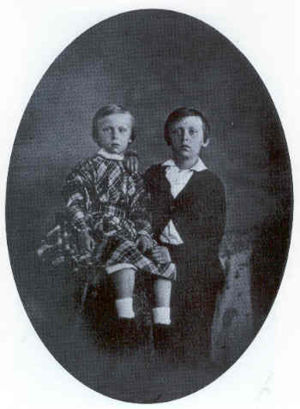| Willem Nicolaas van Oranje-Nassau is geboren in Zuid-Holland na 1811 Join: Netherlands Project Discuss: netherlands |
Contents |
Biography
William, Prince of Orange (Willem Nicolaas Alexander Frederik Karel Hendrik; 4 September 1840 – 11 June 1879), was heir apparent to his father King William III of the Netherlands from 17 March 1849 until his death.
Prince William was the eldest son of King William III of the Netherlands and his first wife, Princess Sophie of Württemberg. At his birth, he held the third position in the line of succession to the Dutch throne and the seventeenth position in the line of succession to the British throne. A month afterwards on 7 October 1840, his great-grandfather, the reigning King William I of the Netherlands, abdicated the throne due to the disappointment over the recent Treaty of London, which recognized the independence of Belgium (previously provinces of the United Kingdom of the Netherlands), and the intention of marrying a Roman Catholic and Belgian noblewoman, Henrietta d'Oultremont. In 1849, after the death of his grandfather King William II of the Netherlands, he became the Prince of Orange as heir apparent. His Victorian upbringing turned out to be a disaster. In 1857, he was appointed the 87th Grand Cross of the Order of the Tower and Sword.
After the failed plans for a marriage between Prince William and Princess Alice of the United Kingdom, the second daughter of Queen Victoria, the prince fell in love with the 19-year-old Countess Mathilde van Limburg-Stirum in 1873. The relationship between the prince and his parents became very problematic, as his parents refused William's wish to accept Mathilde as his bride in 1874. By the standards of the Dutch royal family, a marriage between a member of the royal family and a member of the nobility was considered unequal and therefore unacceptable.Also a rumor circulated that Mathilda was an illegitimate daughter of king William III. The 33-year-old William wanted to marry, if necessary, without the consent of his parents. However, Mathilda was not yet twenty and therefore permission was needed from her parents too. They denied permission and the prince's attempt to marry Mathilda failed. Heavily disillusioned with his situation in the Netherlands, Prince William then went into exile in Paris, where he threw himself into a life of sex, drinking and gambling. He shared life with Henriette Hauser (also Hausser), his Parisian mistress, a "boulevard theatre" actress. The duc de Gramont-Caderousse, a fellow hedonist, gave him the nickname "Prince Lemon" [le prince Citron in French]; the nickname became popular among the regulars in the recently created boulevards and the Parisian newspapers when they reported about his debauched lifestyle. Prince William died at the age of 38 in his apartment in the Rue Auber, near the Paris Opera from a combination of typhus, liver complaints and total exhaustion. On 26 June 1879 his body was entombed in the royal crypt at the New Church of Delft. On his coffin there was a wreath from French Empress Eugénie of France and one from the Prince of Wales (later King Edward VII), who had been his fellow debaucherer.
After his death, his brother Prince Alexander became heir-apparent and Prince of Orange. However he also died before their father, who was now without direct male heirs. Neither his uncle, Prince Henry nor his grand-uncle, Prince Frederick, had any male issue as well. The States-General adopted agnatic-cognatic primogeniture making his half sister, Princess Wilhelmina, heiress presumptive. Up until 1884, the Dutch constitution used a form of Salic Law. Princess Wilhelmina succeeded upon their father's death in 1890.
Titles
- His Royal Highness Prince Willem of the Netherlands, Prince of Orange-Nassau (1840–1849)
- His Royal Highness The Prince of Orange (1849–1879)
Sources
- Wikidata: Item Q587967, en:Wikipedia

- Wikidata: Item Q587967, nl:Wikipedia

Acknowledgments
Thanks to Martyn Grifhorst for starting this profile.
Click the Changes tab for the details of contributions by Martyn and others.
No known carriers of Willem Nicolaas's ancestors' DNA have taken a DNA test.
Have you taken a DNA test? If so, login to add it. If not, see our friends at Ancestry DNA.
Rejected matches › Nicholas Ness (abt.1841-)
Featured Foodie Connections: Willem Nicolaas is 19 degrees from Emeril Lagasse, 16 degrees from Nigella Lawson, 21 degrees from Maggie Beer, 42 degrees from Mary Hunnings, 22 degrees from Joop Braakhekke, 28 degrees from Michael Chow, 25 degrees from Ree Drummond, 24 degrees from Paul Hollywood, 23 degrees from Matty Matheson, 27 degrees from Martha Stewart, 29 degrees from Danny Trejo and 29 degrees from Molly Yeh on our single family tree. Login to find your connection.
V > van Oranje-Nassau > Willem Nicolaas Alexander Frederik Karel Hendrik van Oranje-Nassau
Categories: House of Orange-Nassau | Grand Crosses of the Order of the Tower and Sword | Koninklijke Grafkelder, Delft | Paris, Seine | 's-Gravenhage, Zuid-Holland, Nederland | Dutch Roots PPP | Nederlanders uit Zuid-Holland na 1811


